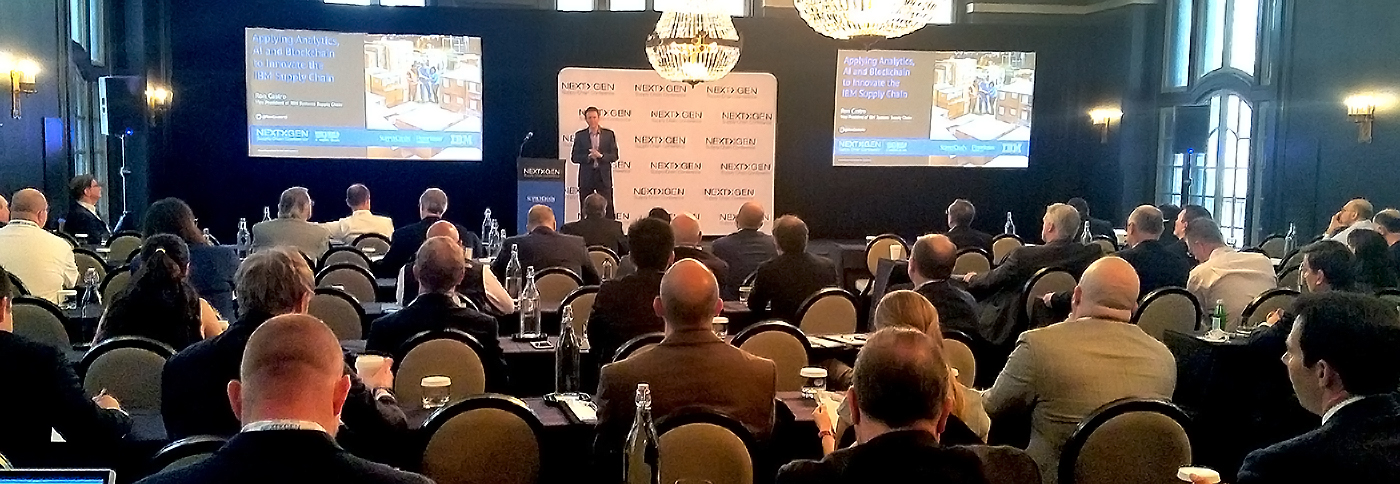With a focus on what's coming next in the supply chain and aimed at an audience of C-level executives, the first annual NextGen Supply Chain Conference took place at the Chicago Athletic Association April 16-17. Held at one of the city's landmark hotels, the two-day event brought together an impressive lineup of industry experts, speakers and academics—all of whom came to answer the question: What's next in supply chain management for senior-level supply chain management professionals?
Over the course of two days, the conference featured case studies from six industry leaders who are putting artificial intelligence (AI), the Internet of Things (IoT), Big Data, predictive analytics, 3D printing and robotic process automation to work in their supply chains. The event also featured a two-hour block on robotics in the warehouse and DC—with two panels of experts sharing their experience and expertise in this growing area—and the first-annual Supply Chain Management Review NextGen Supply Chain Awards, sponsored by IDC.
Sponsored by Honeywell Intelligrated, ASCM, Locus, PINC, IDC, Dematic and other organizations that are helping to advance the NextGen supply chain, the conference also featured cutting-edge technical sessions. Other highlights included nearly a dozen keynotes, sessions and panel discussions on the most important emerging technologies geared to senior level executives, and networking opportunities with peers, consultants, academics and leading providers of supply chain solutions.
For those who could not attend, here's how the conference played out over the two days.
Day 1 highlights: AI, blockchain, and analytics
Ron Castro, IBM's vice president of supply chain, kicked off the conference with the keynote. Castro took the stage to talk about how his company is applying augmented intelligence, blockchain and predictive analytics to expand end-to-end supply chain visibility while also improving operational efficiency. Calling data the “next natural resource for supply chain leaders,” Castro offered examples of how visionaries are using new technologies to “drastically reimagine their operations to deliver exceptional value.”
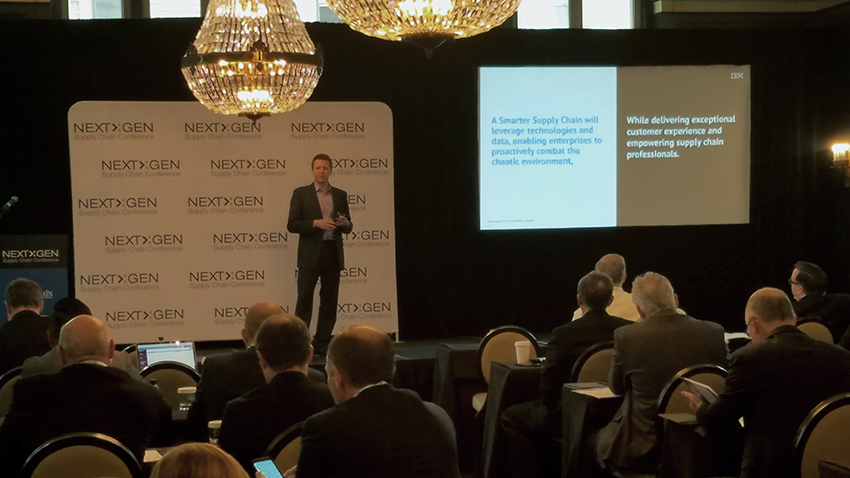
Ron Castro Speaking at the NextGen Supply Chain Conference in April 2019
Pointing to the hybrid Cloud (i.e., a platform for applications and infrastructure, built on two or more components from public Cloud, private Cloud and on-premises IT, according to IBM), Castro said this is one example of how organizations can build data networks in order to establish a secure record of truth. It also enables an understanding of true demand signals and helps supply chain leaders make sense of real-time data.
“When these elements come together,” Castro said, “they cumulatively allow for an efficient supply chain ecosystem that boosts productivity.”
Castro said that trusted transactions in IBM's supply chain include Customs declaration, parts provenance, supplier trust, responsible sourcing (i.e., conflict minerals tracking), contract labor management and precision logistics. He pointed to algorithms and a new data model as the engines that are making these trusted transactions happen, and noted that “most companies don't know what algorithms they have and are not managing them as strategic assets.”
Up next, George Bailey of the Digital Supply Chain Institute explained how today's supply chains are operating under extreme margin pressure and being asked to do more with less. When it comes to technology adoption, he said that transformation is needed on a massive scale. “Most companies are not galloping,” Bailey urged, “and they need to move faster.”
Acknowledging that nearly all organizations have more data than they know what to do with right now, Bailey said the ability to manage algorithms to exploit new data models is a must-have for any company that wants to create an efficient digital supply chain.
Next came the robots. Led by John Santagate of IDC, this segment of the conference included a presentation plus two different panel sessions—one on piece-picking robotics and the other focused on mobile robotics. Santagate began the block with an overview of the real value of robots and explained how early adopters are already benefitting from their capabilities, power, and autonomy. “Robotics is hitting cruising altitude,” he said, “and it's not just about autonomous robots moving pallets around anymore.”
Santagate estimates that the amount of venture capital pouring into the robotics R&D space rose to $12 billion last year, up from $348 million in 2014. As part of that push, he expects flexible robot-enabled automation for companies that wouldn't have otherwise automated as a major growth area. “It's about more than automation,” he explained. “It's about the non-value-added movement of materials and taking the human-enabled movement out of the equation.”
The robotics panel discussion spanned numerous topics, including piece-picking robotics, the convergence of AI and robotics and how to create an “automation-readiness roadmap” for your own company. Participants included MIT's Jeffrey Lipton, Dematic's Crystal A. Parrott, Karen Leavitt of Locus, and Matt Wicks of Honeywell Intelligrated.
During the discussions, Leavitt focused on the selection process and planning that should go into any investment in automation or robotics. “Robots are cool, but cool doesn't pay the bill,” he pointed out. “The question is, will this investment really drive both the top and bottom lines? That's what companies need to answer.”
Pick a solution that's right for your business, 6 River Systems' Fergal Glynn added, and try to avoid pilot purgatory (i.e., where pilot projects travel at a snail's pace, never reaching their full potential). “In the end,” Glynn added, “be sure to ask yourself whether mobile robots will really provide the value that you need.”
Next on the agenda was a case study on Rochester Drug's implementation of mobile piece-picking robots in its DCs. The session was co-presented by Gary Ritzmann, Rochester Drug's director of operations, and IAM Robotics' John Cameron. They discussed the drug company's high staff turnover rates (40% to 60%) thanks to the fact that the modern job market is pushing employees to “seek options that have little to no physical demands, with alternative jobs offering better pay,” according to Ritzmann.
Using IAM's robots, the company was “able to stabilize the workforce and train it for new skillsets,” said Cameron. Other key wins included fast integration with its current enterprise resource planning (ERP) system; robots that pick at or above human speeds; one operator for multiple robots (thus enabling easy ROI), and little or no disruption to existing operations and infrastructure.
To wrap up the first day of the conference, Scott Schiller and Lee Dockstader of HP 3D Printing shared their experiences using 3D printing in the supply chain, with an emphasis on how the company's equipment can create “lighter parts faster, and with the same functionality,” Dockstader said.
After receiving their first-ever Supply Chain Management Review NextGen Supply Chain Awards, representatives from Geodis, IBM, Johnson Controls, DHL, Cisco and IDC participated in a closing award panel that was moderated by Bob Trebilcock and touched on a host of topics of interest to senior-level supply chain executives.
Day 2 highlights: Digitizing the supply chain
“I feel like I'm living in a science fiction novel all of the time,” said Cisco's Jack Allen, a veteran supply chain management expert whose second-day keynote focused on the digitization of the supply chain. “Things are happening now because we imagined them a long time ago,” he added.
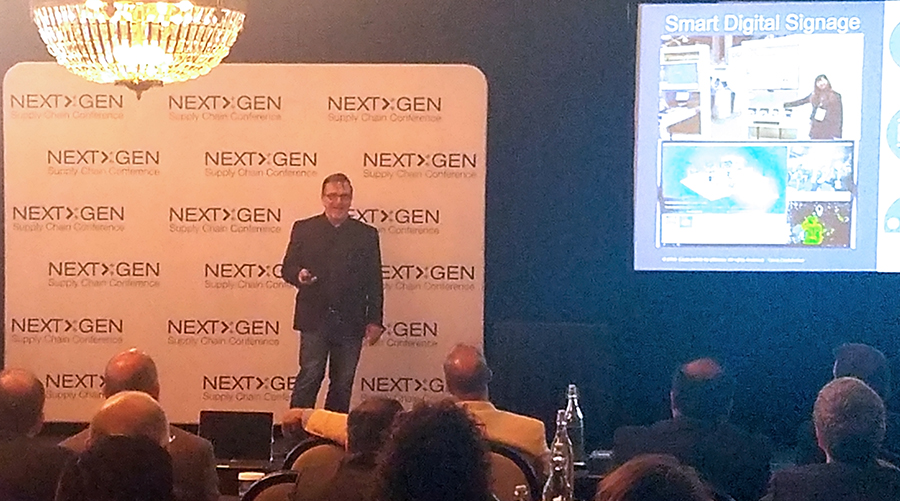
Jack Allen of Cisco speaks to the attendees about NextGen Supply Chain Technologies
Pointing to the increasingly demanding customer as a key driving force behind supply chain digitization (“customers want to know where their stuff is”) Allen spoke to attendees about the criticality of cyber security. He pointed to the recent cyber attack on Maersk as just one example of why security is so important, cited a lack of interoperability as a sticking point and discussed a number of different technologies (AR, blockchain, AI) and how far they've come in the supply chain.
Allen also talked about the circular economy (an economic system aimed at minimizing waste and maximizing resources) and discussed how “failure is learning” in the technology world, noting that “we should all be teaching the management chain that every failure puts you closer to success.”
In his presentation on how AI is transforming the supply chain, Vineet Sinha of Johnson Controls discussed the complexity of the modern-day building, calling it an “ecosystem that we have to keep up and running.” A lot goes into making that happen, he said, and AI can play a crucial role in helping people interact with touchpoints and make a difference in the building maintenance world.
Sinha also talked about the connected equipment business and explained how a typical service request works (e.g., it's time consuming, expensive, reactive in nature). He shared some real-life stories with the audience and discussed how AI helps avoid phone calls, predicts problems before they happen and prevents downtime and repairs.
Up next, three experts presented 30-minute B2B sessions focused on different aspects of supply chain management. Procurant's Eric Peters talked about blockchain's role in the food supply chain and walked attendees through the basics of how the technology works. He discussed blockchain's immutable nature (“you can't break it,” he says), its limitations and its future prospects for supply chains.
The other two short presentations centered on machine learning and autonomous logistics, and DSC's logistics strategies for using technology to improve employee retention in today's tight labor market. To round out the day, TCU Neeley Business School's Morgan Swink talked about how to roadmap your way to digital supply chain maturity; Flex's Marcin Fic used a case study to show what the intelligent supply chain looks like in action; and ASCM's Peter Bolstorff discussed how to accelerate return on digital investments.
With the inaugural event a wrap, planning is already underway for next year's conference.
2019 Sponsors Included:
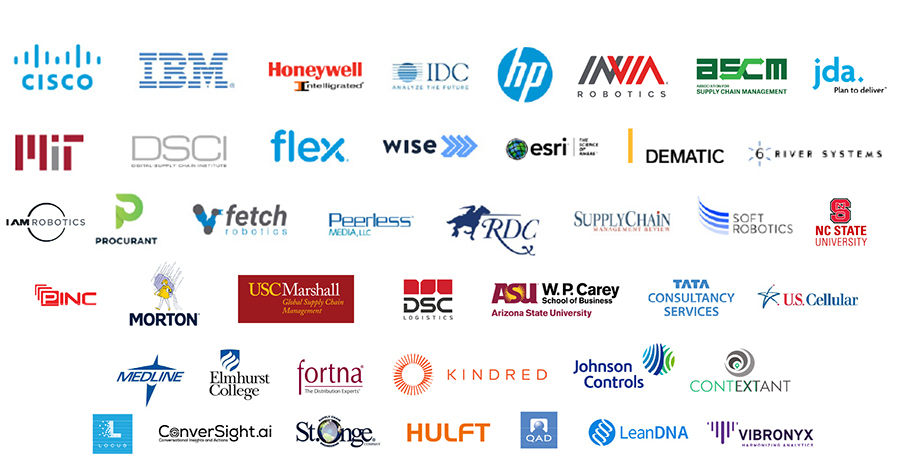
SC
MR
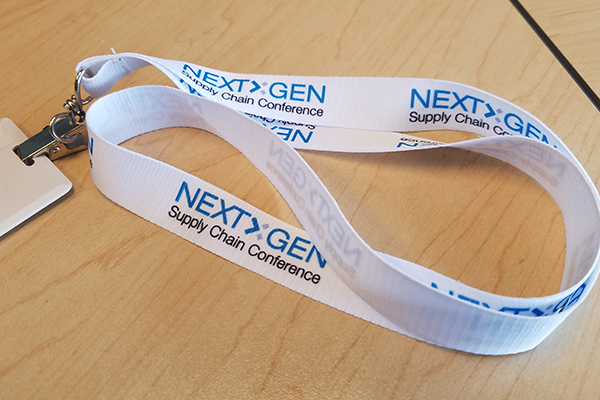

More Events
- Next-Gen SupplyChains: Underpinning your ability to manage complexity and drive innovation
- The Future of Supply Chains: Next-Generation Technology and Beyond
- Thanks to all who made NextGen a success
- Medline Executives’ Keynote to Kick Off NextGen Supply Chain Conference
- NextGen Supply Chain Conference 2022: About our event
- Industry Innovators Take Home 2022 NextGen Supply Chain Awards
- More Events
Latest Podcast

 Explore
Explore
Topics
Software & Technology News
- Technology’s role in mending supply chain fragility after recent disruptions
- Tech investments bring revenue increases, survey finds
- Survey reveals strategies for addressing supply chain, logistics labor shortages
- AI, virtual reality is bringing experiential learning into the modern age
- Humanoid robots’ place in an intralogistics smart robot strategy
- Tips for CIOs to overcome technology talent acquisition troubles
- More Software & Technology
Latest Software & Technology Resources

Subscribe

Supply Chain Management Review delivers the best industry content.

Editors’ Picks





